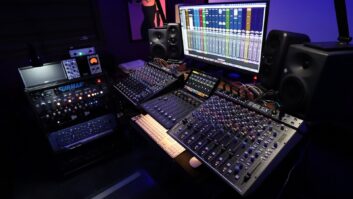Chris Benham at his Argosy-mounted Soundcraft Ghost console in the Big Orange Sheep control room.BROOKLYN, NY—When Chris Benham told his girlfriend at the time—now his wife—to look out for the big horn sheep while she was vacationing in Yellowstone Park, poor cellphone reception caused her to mishear what he said. “Later, she sent me a postcard that mentioned ‘big orange sheep;’ when I decided to build a studio, I knew that had to be the name,” laughs Benham.

Big Orange Sheep officially opened for business at the end of March this year, after a brief hiccup in musician and composer Benham’s plans and a two-year build-out. Occupying 2,000 square feet on the fourth floor of a commercial building just a stone’s throw from the South Brooklyn Marine Terminal, the facility is influenced by a bygone era, featuring natural light and a flexible room layout suited to recording Benham’s passion, live jazz.
“I just wanted to make a studio that I would want to record in,” he says. “A lot of studios—I don’t want to be insulting but—they’re shitholes. There’s an idea that underground is cool, and I’m sympathetic to that. But I wanted to make something a little more classic.”
Benham, a drummer, studied music performance in Las Vegas. “My buddy was into recording engineering and was a paid intern at one of the local studios. They were doing a lot of jingles and he got the bright idea that we could do the same thing. So three of us got together and pooled our resources. A couple of agencies gave us a chance; after a while, we landed a couple of pretty big accounts, and used the money to convert a house in downtown Las Vegas into a studio.”
But the commercial music business changed and the partners went their separate ways, Benham relocating to New York. “I started doing projects out of my apartment,” he recalls, tracking at commercial facilities in the region. At one studio, “I noticed my editing chops were equal to, maybe even better, than the guy who was engineering. He was a good engineer, but I thought, I could do this.”
His initial plan was to build just a small studio. “I found a 1,000-square-foot space, got the architect and mechanical engineer, and was leasing the space for a year. But when it came time to pull the permits, I found that the building wasn’t zoned correctly. It was a wasted year, and I’d paid out all this money.”
He laughs: “The answer was to double down. I realized if I got a larger space, divided it up and had some tenants, I might be able rent a space twice the size for about the same price and do a lot more with it.”
To save money, he had previously hired an architect with no studio experience, and ended up doing all the research himself. “By the end of the process, I knew what needed to be done. Why should I pay a guy? It was a lot quicker for me to just do it.”
Benham did much of the construction at Big Orange Sheep—from the walls, floors and suspended ceilings to the acoustic treatment and sand-filled soundproof doors. A seven-foot 1914 Steinway B Concert Grand piano takes pride of place in the 500-square-foot main tracking space, surrounded by four iso rooms, which Benham designed to accommodate jazz and other ensembles.
“I realized there was an underserved niche. If you wanted to record a big band, you couldn’t have your rhythm section isolated from the horns in any studio that I knew of at the time. The flexibility of being able to play live in the live room, or to have it isolated, was what was missing.”
Benham, who has worked with Robert Goulet, Tony Orlando and the Smothers Brothers, as well as jazz greats including Jack Montrose, Don Menza and Stefan Karlsson, was out of the local scene for a while during construction. But now he is getting back into the swing of things: “I play for a club date service and there’s a jam session at the Kitano Hotel where I play in the house band once or twice a month.”
The centerpiece of the new control room is an Argosy Console 90 Series desk with an integrated 32-channel Soundcraft Ghost analog mixing console, which Benham and his partners bought in 1998 for their studio in Vegas. “I was mixing in the box while thinking everything we mixed on the Ghost sounded better. Having it back, I still feel the same way—it just glues things together a little nicer.”
The Argosy makes a great first impression on clients, he says. “The Argosy looks more professional; it has clean lines, and it’s self-contained.” On-board rackbays house a custom patchbay and a 32-channel Antelope Orion 32 converter and audio interface.
The Argosy console is about the only piece of studio furniture that Benham didn’t personally build. His outboard equipment racks house dbx, Demeter, Empirical Labs, Purple Audio and Urei dynamics processors plus Alesis and Lexicon effects units. “But I knew I wouldn’t be able to do as good a job as Argosy with the console,” he says.
Argosy Console
argosyconsole.com
Big Orange Sheep
bigorangesheep.com







